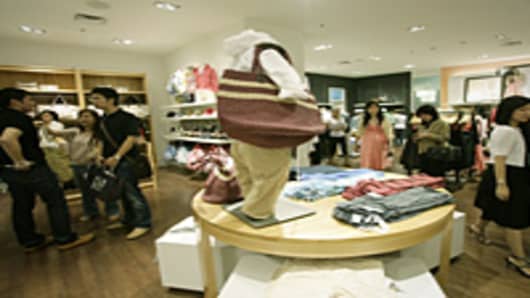State sales-tax holidays and back-to-school buying helped give retailers a modest boost in August, with most retail sectors showing gains, according to a report released on Wednesday.
But consumers clearly remain cautious, and the retail sales trend is more likely to show a tendency to remain stable and flat rather than towards growth, according to SpendingPulse, an information service by MasterCard Advisors that estimates sales for all forms of payment, including cash, checks and credit cards.
"Categories such as apparel and electronics appear to have been helped by the back-to-school season, which tends to peak in August," said Michael McNamara, vice president, research and analysis for SpendingPulse.
Sales of apparel headed back into positive territory in August, rising 2.6 percent from last year. The category, on a year-over-year basis, has logged increases in five of the past 8 months, and was down 1.1 percent in July.
Within the apparel category, sales of clothing for children were the most robust, rising 8.4 percent from last year. But parents appear to have held off on spending for themselves to buy for their growing kids. Sales of both men's and women's apparel continued to slip in the latest month.
After a sharp decline in July, sales of men's apparel fell 1.9 percent in August from last year, while women's apparel sales fell 2.7 percent from the year-ago period. In July, women's apparel sales were down 1.9 percent.
Sales of footwear, continued to show weakness as they have over the past four months. In August, sales in the category inched up 0.9 percent.
"The bias has been to the lower end of the price spectrum. (Consumers) are pointing their wallets at wherever they can find a deal.""
Electronics sales have become a bigger piece of the back-to-school budget, as students buy laptops and other gadgetsto help them with their classes. Both consumer electronics and appliances logged increases in the latest month, with consumer electronics sales up 2.3 percent, and appliances up 9.4 percent.
Online revenue continued to grow in August, but the 7.2 percent gain in the latest month was the smallest year-over-year increase in 2010.
McNamara said he suspects consumers may have headed to brick-and-mortar stores to take advantage of tax holidays rather than purchase goods online.
More than a third of all U.S. states offered residents tax holidays in August, including three states that had not offered a similar event last year. Those states—Florida, Illinois and Massachusetts—are large and likely had a significant impact on sales last month.
The Massachusetts tax break, which waived sales tax on all retail items that cost less than $2,500, was particularly generous.
It will be interesting to see if these tax holidays encouraged more consumers to shop in August. In general, consumers have been holding off on buying items until they absolutely need them. With hot temperatures continuing to dominate much of the country, the weather offered little incentive to shop for fall sweaters and jackets.
The hot and dry conditions, however, helped the overall restaurant sector, while the continued volatile financial markets performance hurt sales of luxury goods, McNamara said.
McNamara also noted that retailers will be facing more difficult comparisons with the year-ago period beginning in September.
"In most categories, consumers are still reluctant to buy," McNamara said. He said the employment picture and consumer confidence will need to improve before consumers can begin making larger purchases on a sustained basis.
Earlier in the week, the Commerce Department reported that Americans spent money at the fastest pace in four months. Still, consumer spending rose only a lackluster 0.4 percent in July, outpacing the increase in personal incomes, which grew only 0.2 percent.
On a more positive note, McNamara said he didn't see signs of excessive discounting. Industry-watchers have been concerned that discounts could accelerate if fall merchandise doesn't move off the shelves.
Discounts have been an important way to lure consumersinto stores as consumers focus on value.
"The bias has been to the lower end of the price spectrum," McNamara said. "They are pointing their wallets at wherever they can find a deal."
Questions? Comments? Email us at consumernation@cnbc.com



